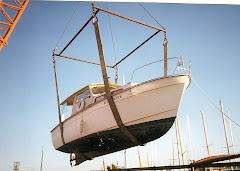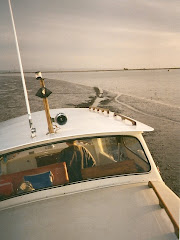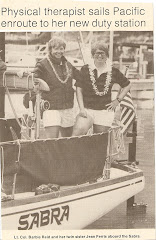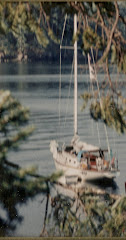The boats, heavily stowed with supplies, are re-launched in the pre dawn darkness. With the tide ebbing and the night skies clear they pulled away quickly from the anchorage and the 16 oarsmen from both boats, stroked with precision the 32 oars into the dark waters. Restoration Point faded into the distance, as did the HMS Discovery and Blake Island. To the south lies the southern inlet in which they will venture. It is called Colvos Passage and it separates the island that is to port from the continental shore. The passage is about 12 miles in length and is about one mile wide. The island to port will be named Vashon in a few days by Captain Vancouver after his and Lt Puget’s good friend, Commander, and later, Admiral, James Vashon, whose command they were under in Jamaica.
 |
Departure leaving Blake to Starboard As Described in Peter Puget by Wing and Newell |
 |
| Departure as described by Mr. Menzie's journal Blake to Port With Vancouver in Inland Washington Waters by Richard Blumenthal |
By dawn, they passed the northern portion of Vashon Island and entered Colvos Passage. At 0800 hrs, they saw an Indian canoe pull up on shore and quickly retreat to the forest. They, too advanced, and landed on shore for their breakfast meal and gave the oarsmen a well deserved rest. They had bucked the tide and rowed for 4 hours. The temperatures had heated up, and by afternoon they suffered from 90° weather. In all my years of living in the pacific northwest I have never seen, nor, felt the likes of 90° in May. I am usually still in layers of turtle necked shirts, long sleeves and fleece vests, well into May and even June!
 |
| Breakfast Place Olalla |
The morning breakfast place of Olalla was located about 6nm south of the headlands of Vashon Island on the western shore. Lt Puget placed trinkets and beads in the canoes to entice the Indians to return from the forest and to show them of their peaceful intentions. There was no mention of what their first meal was, but there was always salted pork in brine and hard tack biscuits, blue spruce beer. The night before the Restoration Point Indians had given the HMS Discovery some fresh venison, but whether they carried any of it with them was not stated. Lt Puget concluded that the lagoon at the back of the inlet was wide and deep enough at high tide to accommodate the HMS Chatham and at low tide it was filled mostly with fresh water.
They departed at 0900 hrs. and had fair winds and a favorable tide. They had taken numerous sounding with 40 fathoms of line but were not able to find bottom. They reached the southern end of the port land mass and concluded that it was an island and for the first time today they saw the majestic snow capped mountain. Lt Puget reported that even though he had not previously mentioned the mountain in his journal, that today’s viewing was the closest and most beautiful view of this mountain that they had seen. In spite of the warm weather the snow penetrates down 2/3 rds of its slopes. Captain Vancouver named the majestic mountain Rainier, after his good friend, Captain Peter Rainier.
 |
| Mt Rainier |
Mt. Rainier is a dominant presence in Puget sound and on clear days, there is nothing more magical and beguiling. I have, in my younger years, climbed 70% of the 14,441 foot summit and hiked the Wonderland Trail, a 100 miles composed of over 22,000 feet of elevation gains as it circumnavigates around the mountain. [Shown in red] Take a look at Google Images for spectacular views.
It is always important to remember that even though they were keeping the continental shore to starboard, they ventured past Vashon Island without ever seeing the entrance to Gig Harbor. It wasn’t until 1841 that Gig Harbor was discovered by Lt Charles Wilkes. They passed Pt. Defiance to port and continued southbound encountering tremendous flooding tides, currents and rip tides. As they struggled to keep the boats stable and headed south bound, they took a sounding and hit bottom with 30 fathoms of line at mid channel, Several Indian canoes were skirting their boats close to the opposite shore. This is the site of the Tacoma Narrows and its newly built double spanned suspension bridge makes for a dominant structure in the Sound.
They are over come by a strong counter-outgoing tide at the point where an inlet immerges to starboard. This is Point Fosdick and Hale Passage. They are forced to take refuge on shore to have dinner and wait out for a lessening tide. Several canoes passed them and entered a cove farther up the passage which they call Indian Cove or Wollochet Bay.
At 1500 hrs the expedition entered Indian Cove, and made contact with about 16 Indians living in temporary housing. They were friendly and offered them some of their drying fish and clams for trinkets and beads. Lt. Puget describes them as being slight in stature, long, black and exceptional dirty hair, their noses and ears were pierced and decorated. All inhabitants were naked. The cove had numerous raspberry and currant and rose plants and was a lovely spot.
They departed and made their way westward through Hale Passage and established their first, evening camp at 8 pm, 2000 hrs on the continental shore that is, now called, Shaw’s Cove. Some authors state they made camp farther out towards Green Point. Several of the Indians had followed them and seemed to be fascinated, as they watched the white sailors quickly made camp, putting up the officer’s tent and preparing for nightfall.
They had traveled about 25, exhausting nautical miles and had clocked in a 16 hour day.
















